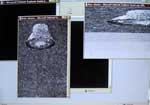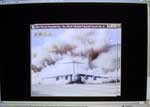Subject : http://www.geocities.com/netart01/
From :
Date : 2003/03/23
Link :http://www.geocities.com/netart01/netart00.htm
From Telecommunication and Network Art to today’s Web Art
The Comtemporary Net.Art
http://www.geocities.com/netart01/text2.htm
...
Sterling and Johnson perfectly qualifies Net.Art here in the sense that it is all about experimenting a new form of Art by combining different traditional and new media with software. A great combination of weird artistic and programming creations that gives birth to innovative hybrid Net-based multimedia (hypermedia) projects claiming the freedom of expression, both in the artistic and literary way. And besides Net.Art is well often realized under the aegis of the temporary autonomous zone of the late 90’s when anarchy and spontaneity let the most marginal and sometimes most interesting works emerge.
For, the content of a great deal of projects often contains social and political claims that aim at criticising different contemporary subjects related to diverse fields of interest (that merit attention to be paid) in interesting and sometimes funny ways. Interactive play on words, virtual humour, graphical subtleties, artistic references, political text-animations, etc… everything is good to exploit in multiple directions.
Such is the case of the opinionated project NoWar.NoGame, for instance. In an effort to symbolise and denigrate War, Jimpunk (the artist’s pseudonym) animates several Internet browser windows in a jerky style, makes pop-up windows that screen different pictures of War tremble like earthquakes, and also makes series of vertical lines, big black points and other basic graphics defile at a certain rhythm, etc… A whole innovative series of metaphors which are accompanied by several real

 voice samples and music backgrounds of historic references used as for representing
and undermining War. The creators of Net.Art are obviously disciples of
cyberpunk ideology with modern and often rather good tastes.At last “the
effect of concept-driven revolution is to explain old things in new ways.
The effect of tool-driven revolution is to discover new things that have
to be explored.”
voice samples and music backgrounds of historic references used as for representing
and undermining War. The creators of Net.Art are obviously disciples of
cyberpunk ideology with modern and often rather good tastes.At last “the
effect of concept-driven revolution is to explain old things in new ways.
The effect of tool-driven revolution is to discover new things that have
to be explored.”Net.Art practice is that way a tool-driven revolution. In fact by always pushing the limits of each medium’s possibilities and also by mixing them all together, Net artists finally lead the digital multimedia and try to go beyond the conventional use of media. For, Peter Weibel, head of the ZKM and curator of Net_Condition, has high hopes for the role Net.Art is about to play. As he says: “At present, Net.Art is the driving force, which is the most radical in transforming the closed system of the aesthetic object of modern Art into the open system of post-modern (or second modern) fields of action.”
Indeed the multidisciplinary Net.Art appears under different categories (as will be analysed): as mainly visualization, sound/music, 3D, interaction/interface, communication, games, and others. Projects can be content based, formal, poetic, ironic, or activist. And the genres can also vary from subversion to interaction, or streaming, browser Art, story-telling, or again to the Net as object.
Finally the evolution of media techniques and software possibilities irrevocably leads to new conception of Art. Net.Art is thus vowed to develop exponentially and to diversify and enlarge. Also, the mix, the addition of techniques, and the complexity of artists intentions incidentally render its concept difficult to discern. I therefore propose to analyse in a brief survey some of the different innovative artistic ideas/concepts, all being created in a more and more prominent interactive sphere.
...
The Interactive and Dynamic Dimensions of Net.Art
Interactivity as the new concept-based production of a New Media Art
2.The phase of Interaction
http://www.geocities.com/netart01/text3.htm
...
Furthermore Net.Art is created in ‘non-formal’ ways and plays and calls upon the participants’ imagination. For, they are very often expected to click on different hyperlinks integrated in different parts of the on-screen-page creation that are not obvious. This is the case for the project Form (here annexed) by Alexei Shulgin, a piece of Web Art humorously constructed on the principles of interactivity. The viewer is here required to click on different parts of the non-linear on-screen pages compositions. In the same way JimPunk (by Jimpunk) features several Net.Art pieces presented under the form of on-screen designs on which one has to click on the different parts in order to experience the different creations. The notion of interactivity is again very central to these artistic creations.
...